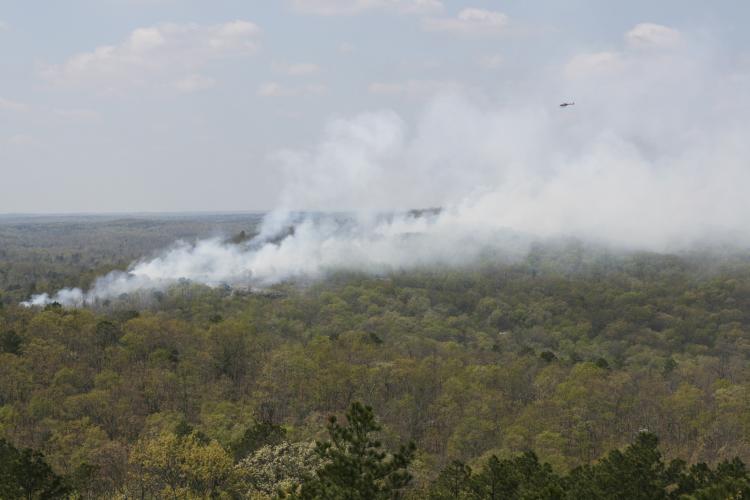
Xplor reconnects kids to nature and helps them find adventure in their own backyard. Free to residents of Missouri.


































Stay in Touch with MDC news, newsletters, events, and manage your subscription

Xplor reconnects kids to nature and helps them find adventure in their own backyard. Free to residents of Missouri.

A monthly publication about conservation in Missouri. Started in 1938, the printed magazine is free to residents of Missouri.






CARTER COUNTY, Mo. -- Where there’s smoke, there’s fire, and there was a lot of smoke over more than 4,000 acres of public land in the Ozarks March 26. A cooperative prescribed burn was used as a vegetation-management tool by the Missouri Department of Conservation (MDC), The Nature Conservancy (TNC) and the National Park Service (NPS).
According to Fire Communication and Education Specialist Dena Matteson of the Ozark National Scenic Riverways (ONSR), 4,010 acres of public land were managed by the landscape-sized burn. Known landmarks involved in the burn included Peck Ranch Conservation Area (CA) and Stegall Mountain, Thorny Mountain and Rocky Falls.
“A prescribed fire of this size mimics the area’s historic fire pattern and reestablishes habitats those fires created and maintained,” said Preston Mabry, area manager at Peck Ranch CA.
Native Americans are known to have burned the area long ago to manage the land. Now, all three agencies have a shared history of using prescribed burns to manage vegetation and wildlife habitat. The first TNC and MDC cooperative burn on Thorny Mountain occurred in 1998, but the two agencies have worked together on prescribed burns in Missouri for more than two decades. TNC has worked extensively with MDC in the prairie regions of the state at places such as Dunn Ranch in northwest Missouri and Wah' Kon-Tah Prairie in southwest Missouri. This work has included controlled burning, native seed harvest and prairie restoration, and wildlife work with prairie chickens and bison reintroductions.
“Working with other agencies allows us to not only share the workload, it enables us to manage habitat on a landscape level,” Mabry said.
A larger, landscape-scale burn is preferred in areas wherever possible because the fire is able to vary across the land with the amount and type of fuel loads such as leaf litter, grass and woody logging debris. Some sections burn more intensely, some less and some not at all. The result is a mosaic of burned landscape that ensures a variety of habitats.
MDC began using the technique more than 30 years ago on Peck Ranch CA. The area was one of the first sites for landscape-sized (approximately 1,000 acres or more) prescribed burns on the state’s diverse Ozarks terrain of forest, hills, valleys and glades.
On this recent, much larger scale burn, all three agencies joined to manage approximately 11 miles of fireline. Eight miles of fireline were within the boundaries of Peck Ranch CA, causing a temporary closure of the burn area to the public during these activities.
Aerial ignition burning was used, according to Mabry, because it allowed area managers to safely light the fire from above and spread it over a larger area. Staff on the ground managed firelines that encompassed the area of the burn.
“These firelines are prepped manually with chainsaws, blowers and hand crews with the objective to move any large fuel away from the firelines,” said Mabry. “Removing standing dead trees close to the fireline helps keep the fire within our prescribed boundaries.”
According to Director of Fire Management Blane Heuman with TNC, approximately 105 acres of the Conservancy’s Thorny Mountain nature preserve were included in the prescribed burn. An additional 895 acres of TNC and MDC lands adjacent to the larger 4,000-acre burn were already successfully burned over the winter months. That burn on the southwest face of Thorny Mountain was completed under the direction of a TNC “Burn Boss” and staffed with experienced teams from TNC's fire program in Arkansas, from MDC and from the NPS.
“This area of black, already burned leaf litter and grass fuels served as the northeast boundary of the larger planned burn on Monday, improving the safety of the larger fire operation,” Heuman said.
According to Acting Superintendent of ONSR Bill Black, maintaining healthy fire-dependent glades and woodlands is essential for stabilizing wildlife populations that depend on these habitats, and will improve the public's opportunity to enjoy a wide variety of wildlife.
"The NPS is proud to work in cooperation with Missouri Department of Conservation and The Nature Conservancy in order to maximize safety and efficiency while accomplishing a project of this magnitude,” said Black. “In addition, prescribed burning will help reduce the accumulation of hazardous fuels and therefore reduce the likelihood of a catastrophic wildfire in the future."